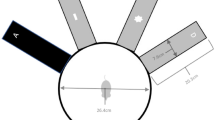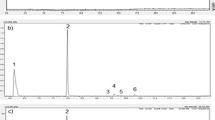Abstract
The stress for 12 sulfur-containing synthetized volatiles was evaluated in male Wistar rats and compared to that for fox-dropping extract concentrate. Stress behavior was analyzed by quantifying various stress responses in a standard open field and measuring the increase in plasma corticosterone concentration. Nine compounds induced stress—a dihydrothiazole, two cyclic polysulfides, five mercaptoketones, and a mercaptan. For the mercaptoketones, the following structure-activity relationships were observed. Size can vary considerably; the mercapto group can be either alpha or beta and either secondary or tertiary. The keto group is not essential, since a structurally related mercaptan remains active. The mercapto group is essential for activity in mercaptoketones, since conversion to a methyl sulfide resulted in a neutral response. This type of odorant could function as an allomone and may have potential in rat control as an area repellent.
Similar content being viewed by others
References
Albone, E.S. 1977. Ecology of mammals—a new focus chemical research.Chem. Br. 13:92–99.
Aylward, F.,Coleman, G., andHaisman, D. 1967. Catty odors in foods: The reaction between mesityl oxide and sulfur compounds in food-stuffs.Chem. and Industry, p. 1563.
Boublik, T., Fried, V., andHala, E. 1973. The vapor pressures of pure substances. Elsevier Amsterdam.
Bullard, R.W., andShumake, S.A. 1977. Applications of chemical signals in wild life management, pp. 368–369,in Miiller-Scharze and Mozell (eds.). Chemical Signals in Vertebrates. Plenum Press, New York.
Carr, W.J., andCaul, W.F. 1962. The effect of castration in rat upon the discrimination of sex odour.Anim. Behav. G.B. 10(1–2):20–27.
Cattarelli, M., Vernet-Maury, E., andChanel, J. 1977. Modulation de l'activite du bulbe olfactif en fonction de la signification des odeurs chez le rat.Physiol. Behav. 19(3):381–389.
Cosser, K., Murray, J., andHolzapfel, G. 1980. Investigation of ribes off-flavor in beer.Tech. Q. Master Brew. Assoc. Am. 17:53–59.
Dravnieks, E. 1977. Correlation of odor intensities and vapor pressures with structural properties of odorants.A.C.S. Symp. 51:11–28.
Eslinger, P.J., Ludvigson, H.W., andReinecke, M.G. 1980. Gas chromatographic analyses of “frustration” and “reward” odors: Initial results, p. 92;in H. Van Der Starre (ed.). Olfaction and Taste VII IRL Press Ltol, London and Washington.
Fromm, E., andBaumann, E. 1889. Veber Thioderivate der Ketone.Ber. Dt. Chem. Ges. 22:1035 and 2592.
Gawienowski, A.M., andStacewics-Sapuntzakis, M. 1978. Attraction of rats to sulfur-compounds.Behav. Biol. 23:267–270.
Krames, L.,Bergman, B., andCarr, W.J. 1968. Responses of male rats to odors from dominant versus submissive conspecific. Meeting of the Animal Behavior Society, Columbus, Ohio.
Lamparsky, P., andSchudel, M. 1971. P. Menthone-8-thiol-3-one, a new component of Bachu leaf oil.Tetrahedron. Lett. 36:3323.
Le Magnen, J. 1951. Etude des phénomènes olfacto-sexuels chez le rat blanc. Variations de l'odeur biologique de la femelle avec son e'tat sexuel et la discrimination de ces odeurs par le mêle adulte.C.R. Soc. Biol. 145:854–857.
Ludvigson, H.W., andSytsma, D. 1967. The sweet small of success: Apparent double alternation in the rat.Psychon. Sci. 9:283.
Maarse, H.,Tennoever, M., andDe Brauw, M. 1974. Another catty odour compound causing air pollution.Chem. Industry, pp. 36–37.
Müller-Schwarze, D., Silverstein, R.M., Müller-Schwarze, C., Singer, A.G., andVolkman, N.J. 1976. Response to a mammalian pheromone and its geometric isomer.J. Chem. Ecol. 2(3):389–398.
Müller-Schwarze, D. andMozell, M.M. 1976. Chemical Signals in Vertebrates. Plenum Press, New York.
Murphy, B.E.P. 1967. Some studies of the protein-binding of steroids and their application to the routine micro and ultramicro measurement of various steroids in body fluids by competitive protein binding radioassay.J. Clin. Endocrinol. 27:973–990.
Orlandi, F., Serra, D., andSotgiu, G. 1973. Electric stimulation of the olfactory mucosa: A new-test for the study of the hypothalamic functionality.Horm. Res. 4:141–152.
Pearce, T.,Peacock, J.,Aylward, F., andHaisman, D. 1967. Catty odours in food: Reactions between hydrogen sulfide and unsaturated ketones.Chem. and Industry, pp. 1562–1563.
Polak, E.H., Trotier, D., andBaliguet, E. 1978. Odor similarities in structurally related odorants.Chem. Senses Flavor 3(4):369–380.
Schildnecht, H., Wilz, I., Enzmann, F., Grund, N., andZiegler, M. 1976. Über das Mustelan, den Analdrüsenstinkstoff des Nerzes (Mustela Vison) und Iltisses (Mustela putorius).Angew. Chem. 88:228.
Singer, A.G., Agosta, W.C., O'Conner, R.J., Pfaffmann, C., Bowen, D.W., andField, F.H. 1976. Dimethyl disulfide: An attractant pheromone in hamster vaginal secretion.Science 191:948–950.
Stacewicz-Sapuntzakis, M., andGawienowski, A.M. 1977. Rat olfactory response to aliphatic acetates.J. Chem. Ecol. 3:411–417.
Steinsholz, K., andSensen, A. 1979. Catty flavour in cheese resulting from the addition of trace amounts of mesityl oxide to the cheese milk.Milchwissenschaft 34:598–599.
Stevens, D. A. 1972. Open-field responses of Rats to odors from stressed and non-stressed predecessors.Behav. Biol. 7:519–525.
Stoffelsma, J., andVernet-Maury, E. 1983. Fox odor analysis (submitted for publication).
Vernet-Maury, E. 1970. Excretion urinaire des catécholamines chez le rat en fonction de l'ambiance olfactive.J. Physiol. Paris 62:461.
Vernet-Maury, E. 1980. Trimethyl-thiazoline in fox feces: A natural alarming substance for the rat.Olfaction Taste VI1:407.
Vernet-Maury, E., andChanel, J. 1967. Comportement émotif chez le rat. Influence de l'odeur d'un congénère.C.R. Acad. Sci. Paris 265D:1408–1411.
Vernet-Maury, E., Le Magnen, J., andChanel, J. 1968. Comportement émotif chez le rat; Influence de l'odeur d'un prédateur et d'un non-prédateur.C.R. Acad. Sci. Paris 267D:331–334.
Vernet-Maury, E., Dubois, P., andChanel, J. 1977. An attempt to isolate and synthesize fox odor.Chemorecept. Abstr. 5:55–56.
Wheeler, J.W. 1976. Insect and mammalian pheromones.Lloydia 39(1):53–59.
Wilson, S.R., Carmack, M., Novotny, M., Jorgenson, J.M., andWhitten, W.K. 1978. Δ3-Isopentenyl methyl sulphide. A new terpenoid in the scent mark of the red fox (Vulpes vulpes).J. Org. Chem. 24:4675–4676.
Yasuhara, Y., andFuwa, K. 1980. Isolation and characterization of odorous components in solid suring manure.Agr. Biol. Chem. 44(10):2379–2385.
Author information
Authors and Affiliations
Rights and permissions
About this article
Cite this article
Vernet-Maury, E., Polak, E.H. & Demael, A. Structure-activity relationship of stress-inducing odorants in the rat. J Chem Ecol 10, 1007–1018 (1984). https://doi.org/10.1007/BF00987509
Received:
Revised:
Issue Date:
DOI: https://doi.org/10.1007/BF00987509




